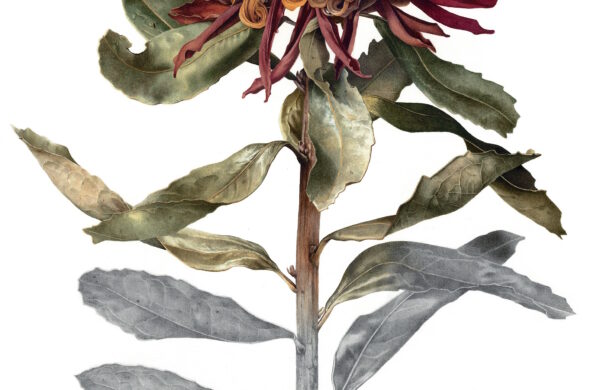The Floral Emblem of South Australia – Sturt’s Desert Pea
Sturt’s Desert Pea is an oldie and a goodie. There are stories throughout time about its origins, discoveries and botanical names. Although this species now commemorates the notable Captain Charles Sturt, the stories of Sturt’s Desert Pea began with a Dreamtime Story from when the world was young. The Legend of the Sturt Desert Pea is a story of love, pain and loss and in that place where the tragedy occurred grew “The Flower of Blood” as the First Nations People call it.
The first explorers who ventured into the southern hemisphere were more interested in the cartography of the Great South Land. In 1699, on his second exploratory visit to the west coast of Australia the former buccaneer, explorer and writer William Dampier (1651-1715) collected several botanical species including the desert pea. He reportedly dried the specimens carefully, pressed the plants between pages of a book and took them together with some seeds, back to England. Today they are in the Herbarium at Oxford University.
Sturt’s Desert Pea, Swainsona formosa is a member of the pea family, Fabaceae and it was adopted as the floral emblem of South Australia on 23 November 1961, using the name Clianthus formosus. This distinctive plant is also on the current south Australian Coat of Arms. Sturt’s Desert Pea grows in Australia in all States except Victoria and Tasmania thriving in arid regions that receive between 125 and 250 mm of rain each year. The plant is a horizontal creeper that runs for up to 2 metres along the ground with soft, silky grey leaves. The stems and leaves are covered in a hairy down. The flower is about 9 cm long, like a bean blossom but larger. The petals are a deep, vibrant red colour with a black swelling known as a boss in the centre. The blooms cluster in groups of six to eight and the species creates a stunning display from Spring through to Summer. Sturt’s Desert Pea seeds can lie dormant until the vital natural elements are in place for germination to occur.
In the 18th century, the pea belonged to the genus Clianthus as Clianthus dampieri and later became more widely known as Clianthus formosus. It was later reclassified in 1990 as Swainsona formosa the name by which it is officially known today. The species was named after the English botanist Isaac Swainson (1746-1812) and formosa, Latin for beautiful. Isaac Swainson was a keen botanist with an interest in medical botany. He was devoted to preparing and successfully marketing a vegetable syrup known as ‘Syrop of De Velnos’ and reputedly made £5,000.
Although Captain Charles Sturt (1795-1869) did not find the inland sea he believed existed on his expedition to central Australia in 1844, Sturt did comment in his journal, Narrative of an Expedition upon the displays of Swainsona formosa. He refers several times to the beauty of the desert pea in flower in contrast to the harsh nature of the plant’s habitat.
Sturt’s Desert Pea is a resilient, eye-catching plant with a story to tell.
Article by Marg Thomas.
Image: Swainsona formosa by Valda Jenkins



